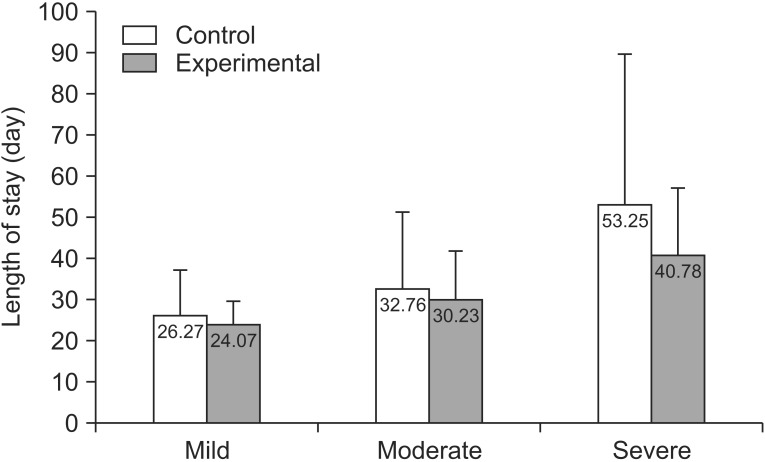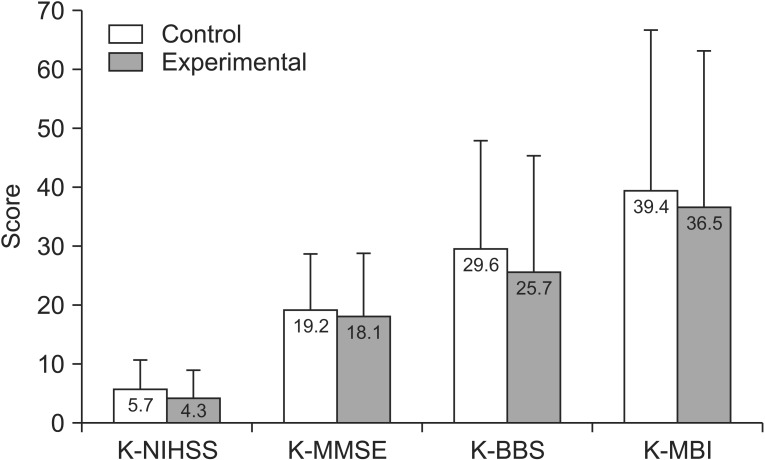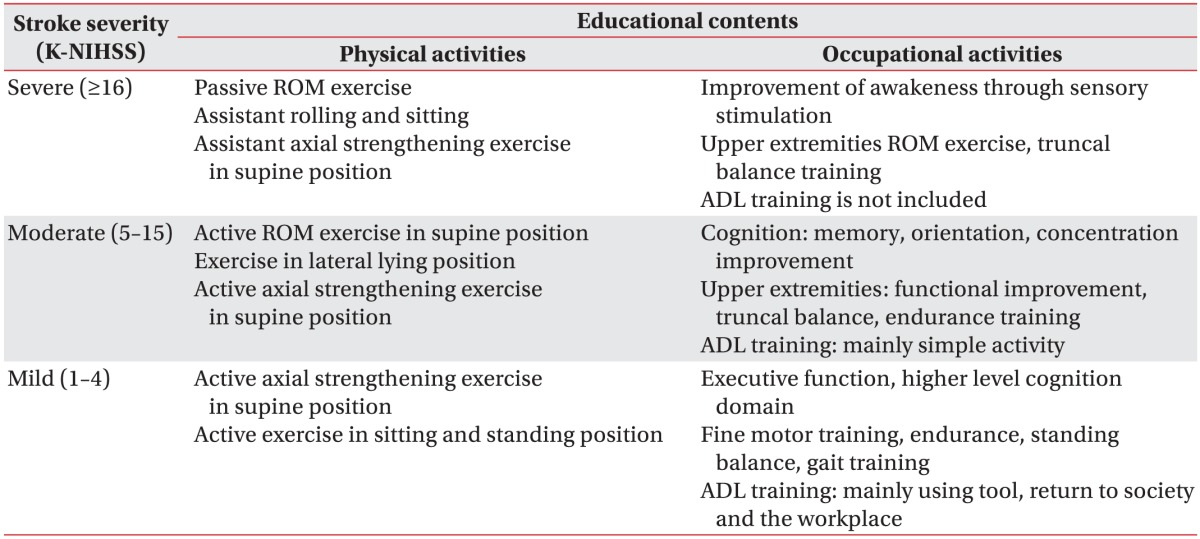INTRODUCTION
Stroke is prevalent among the elderly and a main cause of severe chronic disabilities. The Korea National Health Insurance Service reported that cerebrovascular disease is the third most common disease following cancer and cardiac disease (48.2 persons per 100,000 of the population) in 2014, but mortality rates due to cerebrovascular disease were lower than in 2004. Regarding the latter, acute management including medical treatment (e.g., recombinant tissue plasminogen) and organized interdisciplinary care has improved, and mortality rates decreased accordingly [
1]. However, despite such relatively successful acute medical management, the majority of stroke patients suffer life-long disability [
2]. In a previous long-term study, it was reported that 25%–74% of stroke survivors required assistance to perform activities of daily living (ADL) including feeding, self-care, and mobility [
3].
Considering the prevalence of cerebrovascular disease and residual disability, in stroke, interdisciplinary comprehensive rehabilitation intervention is considered a major management modality for poststroke care, so this type of intervention has increasingly been asked for [
4]. The effect of interdisciplinary comprehensive rehabilitation is strengthened by reiteration and intenseness (high-intensive practice and repetitive task oriented training) [
45]. However, in Korea, a 5-day work week system has been adopted and most hospitals cannot perform rehabilitation therapy at weekends.
Previous reviews have reported that additional exercise programs by therapists at weekends could improve functional recoveries after stroke [
67]. Thus, it stood to reason that additional rehabilitation therapy based on a caregiver's education program could improve functional recovery after stroke. Accordingly, the purpose of this study was to evaluate the effects of rehabilitation therapy on patients' functional recovery by caregivers and the latter group's satisfaction, in addition to daily conventional rehabilitation treatment.
DISCUSSION
In stroke patients, early recovery usually occurs within three months of onset. Subacute stroke recovery continues after three months and the treatment of chronic stroke aims to maintain functional status by use of compensatory techniques [
12]. Furthermore, early intensive rehabilitation treatment is important in enabling patients to achieve maximum recovery [
13]. A previous study reported that caregiver education about basic moving and handling skills, the facilitation of ADL as well as simple nursing tasks reduced caregiver burden, care costs, and helped patients to achieve independence at an early stage [
14]. Another investigation found that family-mediated exercise intervention helped in the facilitation of patient recovery and that, importantly, additional exercise therapy contributed to functional recovery [
15]. In yet another study, the stroke patients' caregiver burden was found to be greater than that of chronic disease patients' careers, such as dementia, hypertension or diabetes mellitus [
16]. In particular, if stroke patients have low ADL abilities and are affected by paralysis, the heavily taxed caregivers and family members benefit from family education programs in terms of decreased physical, social, and emotional burdens [
16]. However, in Korea, few studies have addressed the effect of caregiver education on the functional outcomes of stroke patients and caregiver burden [
14151617].
In this study, we investigated the effect of a caregiver educational program on rehabilitation therapy by examining length of hospital stay, impairment, and functional status in patients, as well as caregiver satisfaction and burden.
Caregivers of patients in the mild and moderate experimental subgroups showed a significant increase in satisfaction and a tendential decrease in burden. Similarly, it was reported that, after an education program, caregivers reported decreases in depression, strain, and an increase of satisfaction levels as compared to controls [
1518]. On the other hand, in severe stroke patients, goal-oriented, repetitive rehabilitation therapy cannot be performed; thus, sensory stimulation is the main approach of occupational and physical rehabilitation programs. Because rehabilitation programs performed by caregivers were restricted in this study, and since severe stroke patients showed less improvement, no increase in satisfaction could be observed in caregivers who provided care for this group as compared with that observed for the mild and moderately affected experimental subgroups.
We compared K-NIHSS, K-MMSE, K-MBI, K-BBS scores at transfer and discharge, but found no significant differences between the experimental and control groups. However, with respect to neurologic impairment, significant differences were observed in K-NIHSS and K-BBS scores between transfer and discharge for the moderate experimental subgroup. These improvements ascribed to the caregiver education program are consistent with findings that showed improvement of neurologic impairment after (physical and occupational) therapists provided an additional exercise program [
19]. The merit of the present study is that it is the first one reporting improvements in non-healthcare workers.
The mild experimental subgroup revealed improvements in each of the above-mentioned variables at discharge. This finding is explained by a ‘ceiling’ effect, since patients with mild stroke acquire fewer overall benefits than more severely affected individuals. Furthermore, recovery in mild severity stroke patients often occurs spontaneously [
15].
In the severe experimental subgroup, functional status did not change significantly after additional rehabilitation therapy by the caregiver's education program, maybe since severe stroke patients can tolerate additional treatment less and require more of the caregiver's time and effort than those who are mildly or moderately affected [
20]. Furthermore, severe patients' brains are more damaged, their cognitive deficits are greater, they are less motivated; thus cannot readily profit from goal-oriented repetitive therapies.
Changes in K-MMSE and K-MBI scores between transfer and discharge did not differ between the control and experimental groups. In the present study, significant improvements in neurologic impairment were observed, but not in functional performance. It was previously reported that muscle strength gain did not directly lead to improvements in functional performance, and that functional independence could be achieved when a patient had a certain level of muscle strength [
20].
Factors affecting functional outcomes have been identified, and depression and cognitive impairment after stroke were commonly observed to adversely affect functional recovery [
21]. However, caregivers had a tendency to spend more time in physical exercise programs than cognitive enhancement ones and also caregiver education did not address depression; thus, it is possible that a lack of cognitive trainings and the presence of depression affected functional recoveries.
To achieve the greatest effects in the treatment of stroke patients, rehabilitation should start as soon as possible, being both intensive and task-specific [
22]. Kim et al. [
23] showed that intensive therapy promotes rapid recovery and reduced hospital stays. Usually, intensive rehabilitation therapy is applied for 45 minutes per session, 5 days a week, with realistic goals set [
24].
In a Japanese study, the effects of rehabilitation treatment for 5 versus 7 days per week were compared using a Functional Independence Measure (FIM). The latter training group had a higher FIM level at discharge and a shorter mean duration of hospital stays [
25]. The Japanese Ministry of Health, Labor, and Welfare acknowledged the importance of continuous intensive rehabilitation treatment for acute stroke patients and extended rehabilitation treatments to include weekends to the extent that 97.9% of institutions now undertake rehabilitation on Saturdays, 69.3% on Sundays, and 85.8% on official holidays [
23]. However, in Korea, medical institutions cannot provide repetitive learning for stroke patients due to time, space, and human resource limitations [
22]. Based on a previous study on intensive acute stroke treatment and our own findings, of the present study, we state that additional and more intensive treatments by caregivers that have undergone an education program could be instrumental in overcoming the lack of resources [
23].
In today's society, the nuclear family unit is becoming more common; family organizations and values are changing. Due to changes in social structure, when a family member experiences stroke, other members find it difficult to offer care and to accept responsibility for the patient. Therefore, numbers of formal caregivers, who care for patients rather than family members, are gradually increasing [
11]. In 2013, a survey of 1,584 Korean medical facilities revealed that the total number of formal caregivers was 17,821—14.7% in tertiary hospitals, 13.2% in general hospitals, and 18.0% in local hospitals [
11].
There were 21 family caregivers and 60 formal caregivers, that is, there were three times as many of the latter. This suggests that education for formal caregivers is becoming an issue of growing importance.
Several limitations must be noted. First, patients were evaluated only at transfer and discharge and there were no long-term follow-ups. Therefore, research about management of longer duration with caregiver's education programs are needed, as well as studies on the maintenance of functioning. Second, we performed physical and occupational treatments, but not psychotherapy. In a review of various caregiver education programs, counseling was found to have momentous beneficial effects on quality of life, emotional status, and caregiver burden [
20]. Hence, we believe that if counseling or other kinds of psychological support are included in education programs, their outcomes will be enhanced.
This study demonstrated that additional rehabilitation therapy as detailed in a caregiver's education program had a positive influence on patients' functional improvements and caregiver satisfaction. Furthermore, it showed that additional rehabilitation therapy promotes patient return to an optimized social life by enhancing functional improvements.








 PDF
PDF ePub
ePub Citation
Citation Print
Print






 XML Download
XML Download